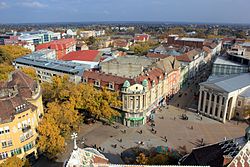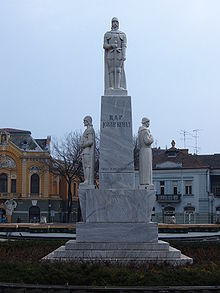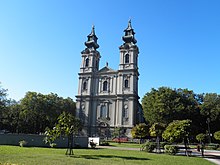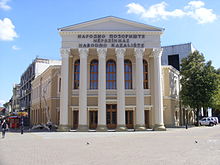| Subotica | ||
 | ||
Coat of arms and flag  | ||
| State | Serbia | |
|---|---|---|
| Region | Vojvodina | |
| Altitude | 109 m a.s.l. | |
| Surface | 164 km² | |
| Inhabitants | 97.910 (2011 census) | |
| Prefix tel | 381 24 | |
| POSTAL CODE | 24000 | |
| Time zone | UTC 1 | |
Position
| ||
| Institutional website | ||
Subotica it's a city Serbian located in the region of Vojvodina.
To know
Subotica is famous for its architecture built between the 19th and 20th centuries, when the city was subject to the Austro-Hungarian Empire. It can easily fit into summer itineraries that include Hungary or Serbia or both countries as Subotica is a border town equidistant from Belgrade is Budapest. You can also choose to stay at Palić, a holiday resort on the shores of the lake of the same name and just about ten kilometers from Subotica.
Geographical notes
Subotica is located in the southern section of the Pannonian plain about ten kilometers from the border with theHungary. Unlike many cities of the Pannonian basin, bathed by majestic rivers. Subotica is crossed by no water course worthy of the name. On the other hand, its eastern countryside presents a series of small lakes of which the best known is Palić.
When to go
May-September is a good time to visit. Subotica has a temperate continental climate with significant annual excursions. The rains are sufficient to maintain the vegetation cover but agriculture draws abundantly from the underground aquifers.
The weather station is located at Palić, on the shores of the lake a few kilometers from the city center; records meteorological data since 1936.
The highest temperature ever recorded from the Palic station was 39.6 ° C on August 15, 1952 and the lowest temperature of -26.7 ° C on February 16, 1954. The record precipitation recorded in one day was 94.3 mm on June 15, 2001 The largest snow cover was 48 cm and occurred on February 6, 1969.
Background

Subotica is first mentioned under the name of Zabadka in a written document dated May 7, 1391. At that time the city belonged to the kingdom of Hungary. After the battle of Mohac in 1526 which saw the defeat of the Hungarian army by the Ottoman Turks, the city with all Voivodina briefly passed under the hands of Jovan Nenad, a Serbian leader to whom the monument in Slobode square is dedicated.
The Turks occupied Subotica in 1542 and were driven out by the Austrians in 1686. Subotica became part of the possessions of the Habsburgs with the Treaty of Karlowitz of 1699, between the Holy League and the Ottoman Empire.
At the time of the revolution of 1848-49, Subotica was the scene of clashes between Serbian and Hungarian nationalities. After the establishment of the Austro-Hungarian Empire in 1867, a great economic development followed which is often called the "golden age" of Subotica. Many schools were opened after 1867 and in 1869 the city was reached by the railway. In 1896 a large power plant was built. The Art Nouveau palaces and churches for which the city is still famous date back to that time.
How to orient yourself
The center of Subotica is divided into the two squares described below:
- 1 Liberty Square (Trg Slobode). The central square is dominated by the town hall from 1912, considered a masterpiece of Art Nouveau in its Hungarian variant. It is a very large square, adorned with fountains and a garden used in summer as a space for concerts, cultural events and fairs. The Palazzo del Teatro also overlooks the square with its Corinthian portico restored to its former glory after a restoration completed in 2018.
- On the right side of the square there is the library building with the statues of the atlases that support the balcony of the noble floor. In the center of the square stands the monument to John Nenad, a historical figure of the sixteenth century who ruled Vojvodina for about a year and risen by Serbian historians as champion of nationalism against Hungarian, Austrian and Ottoman hegemony. Note also the two ceramic fountains, the green one from 1985 and the blue one from 2001, both made with decorative ceramics from the famous Zsolnay factory (Hungary).
- 2 Square of the victims of fascism (Trg žrtava fašizma). It is the square dominated by the late Baroque cathedral in 1779. In the center of the square is the monument to the victims of fascism with a small fountain. Opposite the monument are the Lifka Art cinema and the Kosztolány Dezső theater.
How to get
By bus
- 3 Main suburban bus station (Glavna Autobuska stanica), Senćanski put.
How to get around
What see
Civil architectures

- 1 Town Hall, Trg slobode 1, ☎ 381 24 67 20 20. The palace was built between 1908 and 1912. The decorative features of Art Nouveau are enhanced by a romantic hint of Hungarian folklore, ceramic floral elements and wrought iron decorations. The Council Room with its splendid stained glass windows is the most admired. The 45 m high terrace offers an unforgettable view of Subotica and its surroundings.
_w_Suboticy.jpg/250px-Pałac_Rajhla_(Galeria_Sztuki_Współczesnej)_w_Suboticy.jpg)
- 2 Raichle Palace, Park Ferenca Rajhla 5, ☎ 381 24 553 725.
 M-F 08: 00-19: 00 and Sa 09: 00-13: 00. It was built in 1904 by the architect Ferenc Raichle to be his home and design studio. Expensive materials, the unusual combination of colors, the vivacity of forms, the sumptuous interior and the courtyard make this sumptuous home an exceptional example of Art Nouveau architecture. It houses the “Likovni susret” modern art gallery.
M-F 08: 00-19: 00 and Sa 09: 00-13: 00. It was built in 1904 by the architect Ferenc Raichle to be his home and design studio. Expensive materials, the unusual combination of colors, the vivacity of forms, the sumptuous interior and the courtyard make this sumptuous home an exceptional example of Art Nouveau architecture. It houses the “Likovni susret” modern art gallery.
- 3 Dömötör Palace, Trg synagoge 3, ☎ 381 24 555 128.
 Tue-Sat 10 am-6pm. It was the residence of the Dömötör family built in the Darmstadt Art Nouveau style. It was designed by the Vágó brothers in 1906. Their works had always been decorated with the motif of two birds, which is also present on this facade. It currently houses the civic museum.
Tue-Sat 10 am-6pm. It was the residence of the Dömötör family built in the Darmstadt Art Nouveau style. It was designed by the Vágó brothers in 1906. Their works had always been decorated with the motif of two birds, which is also present on this facade. It currently houses the civic museum.
- 4 Former headquarters of the Savings Bank, Korzo 4. This building was designed by M. Komor and D. Jakab who had just completed the synagogue and were waiting for the municipal building to be assigned to them. The facade is decorated with animals such as the Squirrel - a symbol of diligence, a beehive - a symbol of thriftiness, an owl - a symbol of wisdom.
- 5 Former hotel "Il Vitello d'Oro", Korzo 3. German-influenced Art Nouveau example (Jugendstil) i. The 1904 facade is the work of local architect Titus Mačković. In the 1980s the hotel was demolished and subsequently rebuilt according to the original design.
Religious architectures


- 7 Franciscan church, Trg franjevaca 13, ☎ 381 24 551 256.
 At all prayer times. Consecrated in 1736 and dedicated to St. Michael the Archangel, the church was built inside a ruined medieval fortress. There is an adjoining monastery and a chapel where an image of the Black Madonna is preserved.
At all prayer times. Consecrated in 1736 and dedicated to St. Michael the Archangel, the church was built inside a ruined medieval fortress. There is an adjoining monastery and a chapel where an image of the Black Madonna is preserved.
- 8 Serbian Orthodox Church, Zmaj Jovina 22, ☎ 381 24 522 590. Baroque church from 1726 erected on a slight rise. In 1910 the bell tower and the iconostasis inside was added.
- 9 Serbian Orthodox Church of Alexandrovo, Beogradski put 159, ☎ 381 24 566 122. Small suburban church dedicated to San Demetrius. Its highlight is the Baroque iconostasis from the early 18th century.
- 10 Synagogue, Trg synagoge 2, ☎ 381 24 533 797, 381 63 11 533 20.
 Visits by appointment. Erected in 1902, the Subotica synagogue is one of the finest examples of Art Nouveau. The decorations consist of stylized tulips, carnations and peacock feathers typical of the Hungarian version of the style. With bold and modern architectural solutions, it perfectly harmonizes the structure and decoration.
Visits by appointment. Erected in 1902, the Subotica synagogue is one of the finest examples of Art Nouveau. The decorations consist of stylized tulips, carnations and peacock feathers typical of the Hungarian version of the style. With bold and modern architectural solutions, it perfectly harmonizes the structure and decoration.
- Small synagogue, Dimitrija Tucovića 11, ☎ 381 24 670 970.
- 11 Muhajir Mosque, Karađorđev put 62, ☎ 381 24 52 80 77.
Museums and galleries
- City Museum, Trg synagoge 3, ☎ 381 24 555 128.
 Tue-Sat 10 am-6pm, Sun 10 am-7pm. Housed in the Dömötör palace restored in 2008. The collections document the history of the city.
Tue-Sat 10 am-6pm, Sun 10 am-7pm. Housed in the Dömötör palace restored in 2008. The collections document the history of the city. - Likovni susret modern art gallery, Park Ferenca Rajhla 5, ☎ 381 24 553 725.
 M-F 8 AM-7PM; Sa 9 AM-1PM. Set up in the interior of the Raichle palace, the gallery was inaugurated in 1962. More than 1,200 works by artists active at the time of the former Yugoslav republic are exhibited. Temporary exhibitions and shows are often set up.
M-F 8 AM-7PM; Sa 9 AM-1PM. Set up in the interior of the Raichle palace, the gallery was inaugurated in 1962. More than 1,200 works by artists active at the time of the former Yugoslav republic are exhibited. Temporary exhibitions and shows are often set up.
- 12 Galerija "Dr. Vinko Perčić, Maksima Gorkog 22, ☎ 381 24 530910, 381 24 559 063. There are collections belonging to the doctor Vinko Perčić and works of visual art.
- 13 [link not working]Matija Gubec art gallery, Marka Oreškovića 3, Donji Tavankut (The property is 11 miles from Subotica).
 Visits by appointment. Art collections documenting the folklore of the Vojvodina.
Visits by appointment. Art collections documenting the folklore of the Vojvodina.
Events and parties
What to do
Shopping
How to have fun

Shows
- 1 National Theater, Park Ferenca Rajhla 12, ☎ 381 24 557 436. Bilingual theater. The plays are performed both in Serbian that in Hungarian.
- 2 Kosztolányi Dezső Theater, Trg žrtava fašizma 5, ☎ 381 24 557 471. Repertoire of classical plays from Shakespeare to Brecht.
- 3 Alexander Lifka cinema, Trg žrtava fašizma 5, ☎ 381 24 531 991. Art house cinema dedicated to a pioneer of local cinema.
- 4 Eurocinema, Trg cara Jovana Nenada 15, ☎ 381 24 554 600. Cinema room where current affairs films are shown.
- 5 Children's theater, Park Rajhl Ferenca 12a.
Where to eat
Moderate prices
- 1 [link not working]Fast Food THE BEST 2, Segedinski put, ☎ 381 69 2010818.
 Mon-Sun 00: 00-24: 00.
Mon-Sun 00: 00-24: 00.
Average prices
- 2 Boss Caffe Subotica, Matije Korvina 7-8, ☎ 381 24 551111.
 Mon-Thu 07: 00-00: 00 Fri-Sat 07: 00-01: 00, Sun 09: 00-00: 00. To 2020 the most renowned of restaurants in Subotica.
Mon-Thu 07: 00-00: 00 Fri-Sat 07: 00-01: 00, Sun 09: 00-00: 00. To 2020 the most renowned of restaurants in Subotica.
- 3 Denis, Brace Radić 24.
 Mon-Thu 09: 00-00: 00, Fri-Sat 09: 00-01: 00, Sun 10: 00-00: 00. Pizzeria.
Mon-Thu 09: 00-00: 00, Fri-Sat 09: 00-01: 00, Sun 10: 00-00: 00. Pizzeria.
- 4 Restaurant Bates, Vuka Karadžića 17, ☎ 381 24 556008.
 Mon-Sat 10: 00-22: 00, Sun 11: 00-16: 00.
Mon-Sat 10: 00-22: 00, Sun 11: 00-16: 00.
Where stay
Safety
Since July 2015, the Serbian-Hungarian border has been fenced along its entire arc (175 km) with metal nets and barbed wire to repel immigrants who have entered the European Union from its south-eastern borders (Greece / Turkey). The fence is guarded day and night by paramilitary formations equipped with wolf dogs. In January 2020, guards from the European Border Police were added.
How to keep in touch
Around
.jpg/220px-Палић_-_panoramio_(6).jpg)
- 4 Palić (9 km) - Holiday resort on the lake of the same name with a large number of clubs and hotels of all categories and with the possibility of thermal treatments.
- 5 Seghedino (45 km) - City Hungarian bathed by the Tisza with many interesting monuments and with a culinary tradition linked to paprika.
- 6 Sombor (58 km) - City of about 50,000 inhabitants with interesting architecture gathered around its central square.

